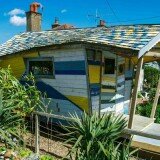The Ideal Building Lot – The Specialist’s Say
The road to a home on the ground, as we say colloquially, begins with the land lot that it will be built on. Its surface is very important in this process because, no matter how dolled up the house may be, it risks ending up hidden among neighboring buildings. We sat and talked to a specialist, Bogdan Patras – an architect who runs the websites Archipelag.ro and Arhitectbucuresti.ro to find out what the ideal plot on which to build a house looks like.
“There is no concrete figure here, it depends on the individual needs. First, it depends on the location, if it suits the client and its expectations. So it is first a matter of personal choice. Then we should be aware that in the city are quite a few constraints: the land can be in a protected area where there can be quite a few problems in setting up the dead wall, adjoining which involves many licenses and which makes the job more difficult. The situation is different in areas where buildings are sparse and consequently there are not so big constraints. But in principle, a good architect should adjust to any terrain and should make a good job out of it. But again, it all depends on what the end customer prefers and needs. I, for example, dealt with a customer who wanted to rebuild in a now protected area. He did not want to give up that land and insisted on building there. But he ran into a lot of problems, for the terrain lies in an ideal position, but not from the perspective of the construction process itself,” said our interlocutor.
Beyond the preferences of the future owner, I insisted on getting some figures. “In principle, it is necessary, in my view, the land lot has an opening of at least 12 to 15 meters so they can build something decent on it. But there is a solution for a narrow land until 10 meters, too, if local urban regulations allow”, said Bogdan Patras.
As for the surface, there is a lower limit below which a builder cannot go, he further said. “In any case, a land lot is not buildable under 150 square meters. This situation is common in urban areas where we have small plots of land. So from 150 square meters up to, say, 200-250, the lot can built on, but with many constraints, as I said. From 250-350 square meters up, we are talking about a land that can be built on easily given that we have an enough opening”, he added.
The ideal building lot – keep an eye on the soil, too
What constraints are these Bogdan Patras is referring to? “We are talking about legal constraints generated by local regulations specific to each local urban areas. For instance, if there is an adjacent building, then the process is more complicated in that it requires an expertise of neighboring buildings so that new building could be joined. These things will eventually raise the construction costs. On the other hand, it creates discomfort for the recipient because windows cannot be placed on these sides, which means limited access to natural light. In congested areas, there is another risk of discomfort because a taller building could be built nearby and that affects the neighbor from the same perspective. Consequently, a decent building land lot should start from 300-350 square meters “, the architect said.
What are the criteria for selection of a building land lot, we further wanted to know? “We have to take into account the cardinal points, because orientation is important. For example, if we have the main façade to the north, this is a pretty big disadvantage. Then we talk about the nature of the foundation soil. One has to order a geotechnical study of the land to make sure the ground doesn’t pose any subsequent problems in the building process, because I have seen such cases, the underground water layer was very high, at about 90 cm below the ground surface, which raises big issues for the foundation and requires special technology, “explained Bogdan Patras.
“Also, the land can be in the protected area of a main heating or gas pipeline, for instance, and then a good part of the land is not usable at all. I have encountered situations where a pipeline crossed a land diagonally and construction on it was almost ruled out. The owner did not know about it and when he applied for permits he had to face this sad reality. Or I had to do with land in the protected area of a lake or a historical monument, again impossible to build on them. Therefore, before buying land, one should consult with an architect or more and they then guide him in choosing the right land. Last but not least, access to utilities, roads and everything related to urban infrastructure – water, gas and electricity, because their absence then entails large investments”, the expert concluded.















